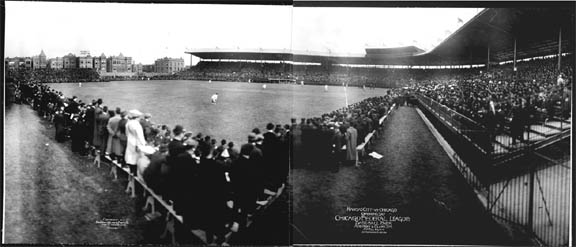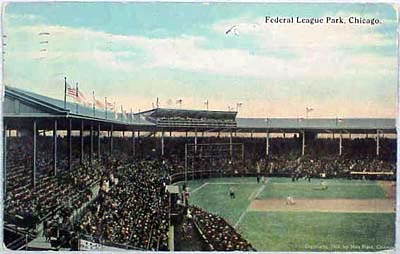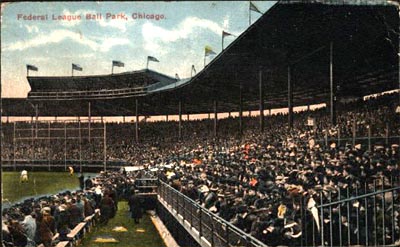The ballpark was designed by Zachary Taylor Davis, who was the same architect of Comiskey Park, the South Side home of the Chicago White Sox. It originally seated 14,000 customers and was a single-decked park. In compliance with the fire codes of Chicago, Weeghman Park was fireproof, being built of steel and concrete. The park was constructed at a cost of $250,000 in 1914 and took only 2 months to build.
- February 23rd: Land is cleared of buildings and houses at Clark and Addison street.
- March 4th: Groundbreaking ceremony.
- March 16th: Start of steel infrastructure.
- March 28th: Steel infrastructure completed.
- April 2nd: Union construction workers go on strike.
- April 4th: Strike ends.
- April 18th: Construction of scoreboard is completed.
- April 19th: Final work on walls, plumbing, and infield completed.
- April 23rd: Opening day, Kansas City vs. Chicago.
Almost as soon as the ballpark was finished, Herman and Margarita Croon of 3699 N. Sheffield Street (behind the rightfield wall) threatened to bring a law suit, claiming that the Whales had violated a city ordinance by failing to get the consent of the property owners adjacent to the ballpark.
During the first series played at Weeghman Park, 9 home runs were hit by both the Whales and the visiting Kansas City Packers. Weeghman thought this was too much and on the off-day following the series, Weeghman had the leftfield wall moved back 25 feet.
Charles Weeghman brought many innovations into baseball. He was the first owner to allow spectators to keep balls hit into the stands. Prior to Weeghman's generosity, fans were expected to return the balls to an usher or they could be thrown out of the ballpark and possibly arrested.
Another innovation was offering weekly discount to women on general admission tickets. This Ladies Day was not really a new idea but the National League had placed a ban on this promotion since 1909.
Then as now, vendors hawked their wares by walking amongst the fans throughout the ballpark. Many fans complained at the boisterous bellowing and the constant obstruction of their view of the action on the field by the vendors. The Whales owner, listened to his fans and constructed concessionaire stands behind the stands.
After the Federal League folded after the 1915 season, Charles Weeghman was given the opportunity to buy the National League Chicago Cubs. Weeghman purchased the Cubs and moved the team to Weeghman Park, which was then renamed Cubs Park. In 1918, Weeghman sold the Cubs and the ballpark to William Wrigley. In 1926, renovation work was done on Cubs Park and was then named after the team owner, Wrigley Field.
| Original Dimensions | ||
|---|---|---|
| LF | CF | RF |
| 310' | 440' | 345' |
Pictures of Weeghman Park
Opening Day at Weeghman ParkKansas City vs. Chicago - April 23, 1914

2 Postcards of Weeghman Park from 1914-1915

